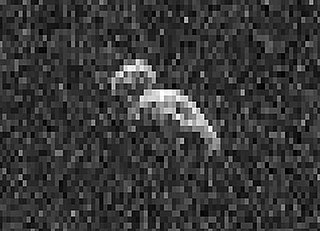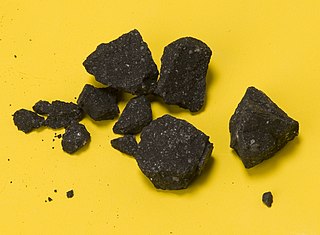Related Research Articles

A meteor, known colloquially as a shooting star, is a glowing streak of a small body going through Earth's atmosphere, after being heated to incandescence by collisions with air molecules in the upper atmosphere, creating a streak of light via its rapid motion and sometimes also by shedding glowing material in its wake. Although a meteor may seem to be a few thousand feet from the Earth, meteors typically occur in the mesosphere at altitudes from 76 to 100 km. The root word meteor comes from the Greek meteōros, meaning "high in the air".

A near-Earth object (NEO) is any small Solar System body orbiting the Sun whose closest approach to the Sun (perihelion) is less than 1.3 times the Earth–Sun distance. This definition applies to the object's orbit around the Sun, rather than its current position, thus an object with such an orbit is considered an NEO even at times when it is far from making a close approach of Earth. If an NEO's orbit crosses the Earth's orbit, and the object is larger than 140 meters (460 ft) across, it is considered a potentially hazardous object (PHO). Most known PHOs and NEOs are asteroids, but about a third of a percent are comets.

A meteoroid is a small rocky or metallic body in outer space. Meteoroids are distinguished as objects significantly smaller than asteroids, ranging in size from grains to objects up to a meter wide. Objects smaller than meteoroids are classified as micrometeoroids or space dust. Many are fragments from comets or asteroids, whereas others are collision impact debris ejected from bodies such as the Moon or Mars.

An impact event is a collision between astronomical objects causing measurable effects. Impact events have been found to regularly occur in planetary systems, though the most frequent involve asteroids, comets or meteoroids and have minimal effect. When large objects impact terrestrial planets such as the Earth, there can be significant physical and biospheric consequences, as the impacting body is usually traveling at several kilometres a second, though atmospheres mitigate many surface impacts through atmospheric entry. Impact craters and structures are dominant landforms on many of the Solar System's solid objects and present the strongest empirical evidence for their frequency and scale.

A meteor shower is a celestial event in which a number of meteors are observed to radiate, or originate, from one point in the night sky. These meteors are caused by streams of cosmic debris called meteoroids entering Earth's atmosphere at extremely high speeds on parallel trajectories. Most meteors are smaller than a grain of sand, so almost all of them disintegrate and never hit the Earth's surface. Very intense or unusual meteor showers are known as meteor outbursts and meteor storms, which produce at least 1,000 meteors an hour, most notably from the Leonids. The Meteor Data Centre lists over 900 suspected meteor showers of which about 100 are well established. Several organizations point to viewing opportunities on the Internet. NASA maintains a daily map of active meteor showers.
Green fireballs are a type of unidentified flying object (UFO) that has been reported since the early 1950s. Early sightings primarily occurred in the southwestern United States, particularly in New Mexico. Although some ufologists and ufology organizations consider green fireballs to be of artificial extraterrestrial origin, mainstream explanations have been provided, including natural bolides.
The Taurids are an annual meteor shower, associated with the comet Encke. The Taurids are actually two separate showers, with a Southern and a Northern component. The Southern Taurids originated from Comet Encke, while the Northern Taurids originated from the asteroid 2004 TG10, possibly a large fragment of Encke due to its similar orbital parameters. They are named after their radiant point in the constellation Taurus, where they are seen to come from in the sky. Because of their occurrence in late October and early November, they are also called Halloween fireballs. Since 2P/Encke is such a short period comet, the meteors have the slowest impact speed of the annual well-known meteor showers.

Yushu, also Romanized as Yüxü, is a county-level city of Yushu Tibetan Autonomous Prefecture in Southern Qinghai Province, China. It comprises a surface area of 13,462 square kilometres (5,198 sq mi). In 2010, the overall city's population was 120,447 and 56,802 live within the city core. There are around 356,000 people in the metropolitan area in 2020. Yushu is the fourth largest city in Qinghai.

An interstellar object is an astronomical object in interstellar space that is not gravitationally bound to a star. This term can also be applied to an object that is on an interstellar trajectory but is temporarily passing close to a star, such as certain asteroids and comets. In the latter case, the object may be called an interstellar interloper.

A meteor air burst is a type of air burst in which a meteoroid explodes after entering a planetary body's atmosphere. This fate leads them to be called fireballs or bolides, with the brightest air bursts known as superbolides. Such meteoroids were originally asteroids and comets of a few to several tens of meters in diameter. This separates them from the much smaller and far more common "shooting stars", that usually burn up quickly upon atmospheric entry.

The Sutter's Mill meteorite is a carbonaceous chondrite which entered the Earth's atmosphere and broke up at about 07:51 Pacific Time on April 22, 2012, with fragments landing in the United States. The name comes from Sutter's Mill, a California Gold Rush site, near which some pieces were recovered. Meteor astronomer Peter Jenniskens assigned Sutter's Mill (SM) numbers to each meteorite, with the documented find location preserving information about where a given meteorite was located in the impacting meteoroid. As of May 2014, 79 fragments had been publicly documented with a find location. The largest (SM53) weighs 205 grams (7.2 oz), and the second largest (SM50) weighs 42 grams (1.5 oz).

The Novato meteorite is an ordinary chondrite which entered the Earth's atmosphere and broke up over Northern California at 19:44 Pacific Time on 17 October 2012. The falling bolide created a bright fireball and sonic booms and fragmented into smaller pieces as the intense friction of passing through the atmosphere heated it and absorbed its kinetic energy. The meteoroid was about 35 centimeters (14 in) across.

The Chelyabinsk meteor was a superbolide that entered Earth's atmosphere over the southern Ural region in Russia on 15 February 2013 at about 09:20 YEKT. It was caused by an approximately 18 m (60 ft) diameter, 9,100-tonne (10,000-short-ton) near-Earth asteroid that entered the atmosphere at a shallow 18‐degree angle with a speed relative to Earth of 19 kilometres per second. The light from the meteor was briefly brighter than the Sun, visible as far as 100 km (60 mi) away. It was observed in a wide area of the region and in neighbouring republics. Some eyewitnesses also reported feeling intense heat from the fireball.
The 2015 Kerala fireball was a meteor air burst that occurred over Kerala state in India on 27 February 2015.

On September 7, 2015, at about 08:40 local time a bolide meteor appeared over Thailand and burned up approximately 100 km (62 mi) above the ground. The meteor briefly flared up producing a green and orange glow before disappearing without a sound of explosion and leaving a white smoke trail. The meteor was recorded by several dashcams during the morning rush hour in Bangkok, and sightings were also reported in Thai towns of Kanchanaburi and Nakhon Ratchasima. The meteor was visible for about four seconds before fading out. As of September 8, 2015 no strewn field has been found. The impact energy was the largest of 2015 at 3.9 kiloton. The last impact this large was on 23 August 2014 over the Southern Ocean.
On October 4, 2017 around 8:07 PM local time, an extremely bright meteoroid fell over the northern Yunnan province of China, reaching maximum brightness roughly 37 kilometres above the ground. The 8-second superbolide was widely recorded, as it fell in the late evening on the Mid-Autumn Festival, a fairly popular festival in China.

2018 LA, also known as ZLAF9B2, was a small Apollo near-Earth asteroid 2.6–3.8 m (9–12 ft) in mean diameter that impacted the atmosphere with small fragments reaching the Earth at roughly 16:44 UTC on 2 June 2018 near the border of Botswana and South Africa. It had been discovered only 8 hours earlier by the Mount Lemmon Survey, Arizona and based on 1+1⁄2 hours of observations, was calculated to have a roughly 85% chance of impact likely somewhere between Australia and Madagascar.
2011 ES4 (also written 2011 ES4) is an Apollo near-Earth asteroid roughly 22–49 meters (72–160 feet) in diameter. It was first observed on 2 March 2011 when the asteroid was about 0.054 AU (8,100,000 km; 5,000,000 mi) from Earth and had a solar elongation of 159 degrees. It passed closest approach to Earth on 13 March 2011. Before the 2020 approach, the asteroid had a short observation arc of 4 days and had not been observed since March 2011. The asteroid was expected to pass within 1 lunar distance of Earth in early September 2020, but did not. There was no risk of a 2020 impact because the line of variation (LOV) did not pass through where Earth would be, and the closest possible 2020 Earth approach was about 0.00047 AU (70,000 km; 44,000 mi). One line of variation showed the asteroid passing closest to Earth on 5 September 2020 at 0.06 AU (9,000,000 km; 5,600,000 mi) with a magnitude of 23, which would place it near the limiting magnitude of even the best automated astronomical surveys.
2018 VP1 is an Apollo near-Earth asteroid roughly 2 meters (7 feet) in diameter. The asteroid had a 0.41% chance (1 in 240) of impacting Earth on 2 November 2020 01:12 UT. It was discovered on 3 November 2018 when it was about 0.003 AU (450,000 km; 280,000 mi) from Earth and had a solar elongation of 165 degrees. The asteroid has a short 12.9 day observation arc. It was last observed on 16 November 2018 by the European Southern Observatory Very Large Telescope at apparent magnitude 26 pushing the telescope close to the limiting magnitude.
References
- 1 2 3 4 Fireball and Bolide Reports (JPL)
- ↑ Carbognani, Albino (2021). "The great Chinese fireball of December 22, 2020". The European Physical Journal Plus. 136 (6): 616. arXiv: 2101.02457 . Bibcode:2021EPJP..136..616C. doi:10.1140/epjp/s13360-021-01504-x. S2CID 230799414.
- 1 2 "Viral videos: Giant 'fireball' falls from sky, crashes into Chinese province". 26 December 2020.


